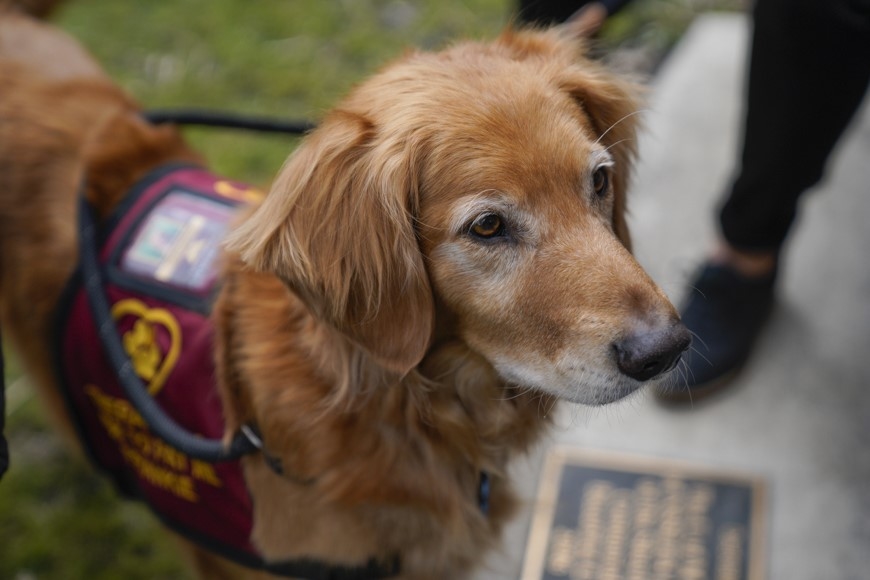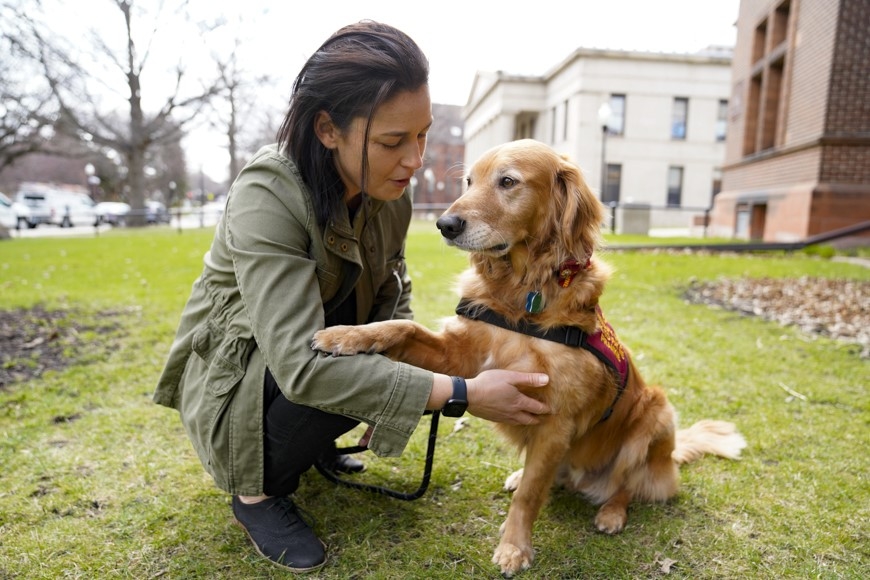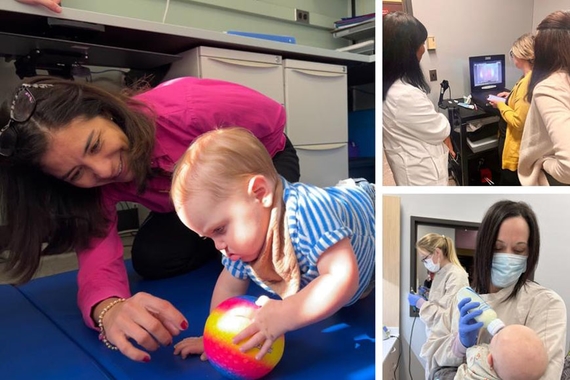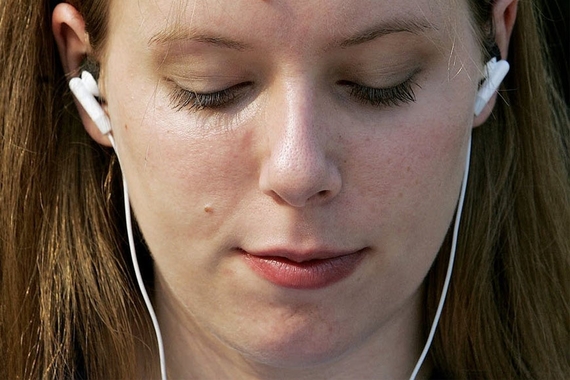“Dogs Accept Everyone for Who They Are”
Frankie, a mini goldendoodle therapy dog, has been creating “a very safe and comfortable environment” for the clients he works with. Erin Bodner, Clinical Supervisor and Frankie’s handler, knows well how he has helped both those at the University of Minnesota’s Julia M. Davis Speech-Language-Hearing Center and those in the public school system.
“Dogs accept everyone for who they are,” Bodner says.
The Julia M. Davis Speech-Language-Hearing Center is an educational clinic on campus. Its main purpose is to prepare graduate students for careers in speech-language pathology by providing an opportunity to work with clients. Bodner is a clinical supervisor for the graduate program in speech-language pathology at the Davis Center and helps train graduate students in delivering therapy services. One of Bodner’s areas of speciality is working with children and adults who stutter. At the Davis Center, Frankie works with Bodner to help clients work on skills such as identifying and communicating emotions, improving social and interpersonal interactions, and gaining communication confidence.
Before working at the Davis Center, Bodner worked in the public school system for 13 years. A graduate of the University’s Master of Art’s program in speech-language pathology, she was glad to return to the university where she “loved her experience” and “always felt it would be a great place to work.” This past fall Bodner introduced Frankie, who spent four years working in public schools with her, to the Department of Speech-Language-Hearing Sciences (SLHS), and he has already made a notable impact among clients, students, and staff.
Frankie’s Journey
Frankie is the only therapy animal at SLHS, and while he is still “relatively young” in his university career, his experience and personality have allowed him to make the most of that role.
From a young age, Frankie’s “calm disposition” made him a prime candidate for duties as a therapy animal, Bodner explains. She says, “the human connection is often so remarkably fast and strong, and I can see that in terms of how [Frankie] connects and the relationships he forms with clients.”
Despite being at his Davis Center job a little less than a year, Frankie has become a treasure among clients, graduate students, and staff in the department. From people checking in on his birthday—which is April 19—to including him in a game of Jenga, Bodner reflects there is a “sense of community that forms around him,” which is difficult to deny after one receives a ‘Therapy Dog Frankie’ baseball card or attends his office hours.
Animal-Assisted Intervention in Speech-Language Pathology
Animal-assisted intervention, the participation of an animal during therapy, is “incorporated into a variety of disciplines, including speech therapy,” Bodner says. Dogs tend to be a popular choice for animal-assisted intervention, but the type of animal used in the practice can be anything from cats to turtles to ferrets.
The exact way in which Frankie works with a client varies session-by-session, however his general role is to be a non-judgmental audience for clients as they practice communication and other speech-language skills without the tension that may come from person-to-person interaction. “Animals are just non-judgmental in their nature,” Bodner says. “They can play a really important role in therapy sessions.”
Clients’ abilities to work with Frankie with no worry of judgment establishes crucial connections that Bodner believes to be important in therapy. He has “a great ability to produce and understand communication signals,” so clients are able to speak freely and productively while feeling understood. “[Working with Frankie] gives clients a reason to talk and communicate.”
Frankie’s tricks, from “sitting pretty” to high-fiving can act as fun incentives for clients to grow in their verbal and non-verbal communication and social abilities.
Clients also work “a lot on independent living skills,” and as a pet owner, Bodner realizes that “having a therapy dog is an opportunity to talk about responsibility, [through] aspects of pet care, and what it means to be a pet owner.”
Frankie’s presence alone encourages productivity, Bodner says. “Clients, particularly younger clients, when they see Frankie, they’re motivated to work hard, to feel like they want to do their best and be their best selves,” she explains. “He’s really good at teaching empathy.”
A Canine Good Citizen
“Frankie’s been the first therapy animal experience for the Davis Center, and it’s been a positive experience,” reflects Bodner. “If he could sit on everyone’s lap, I think he would.”
Unfortunately for Frankie, his status as a lap dog is debatable. Regardless, as he continues his career at the University, the adoration of the self-proclaimed ‘Canine Good Citizen’ will only grow.
@therapydogfrankie
For more, Frankie’s fans can follow his Instagram page, @therapydogfrankie, as well as catch him wearing his graduation cap and maroon-and-gold bow tie at graduation festivities.







